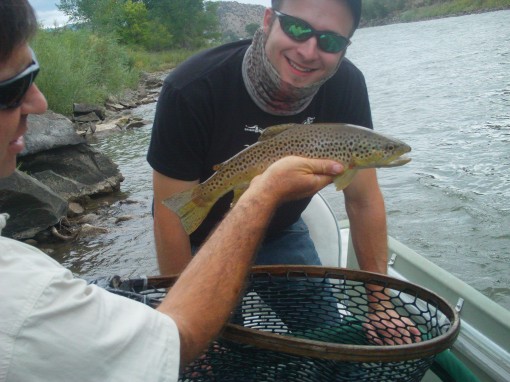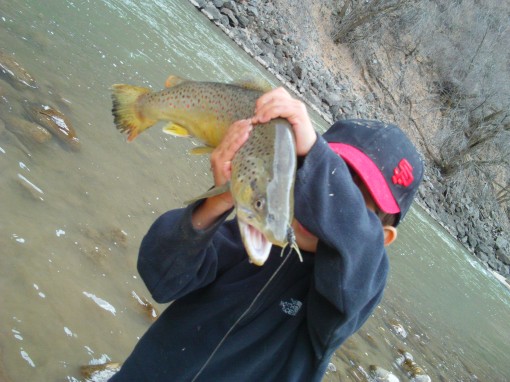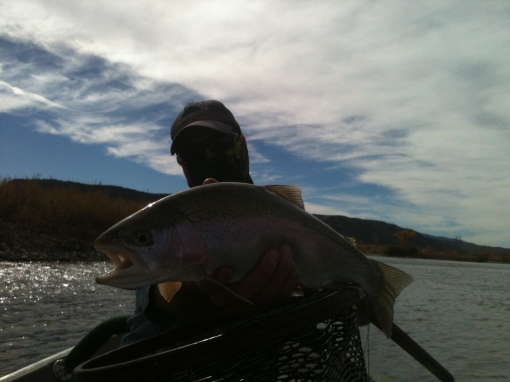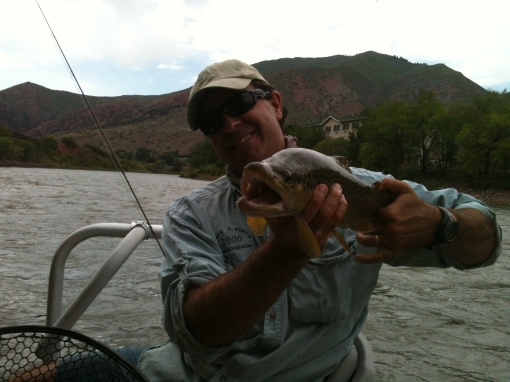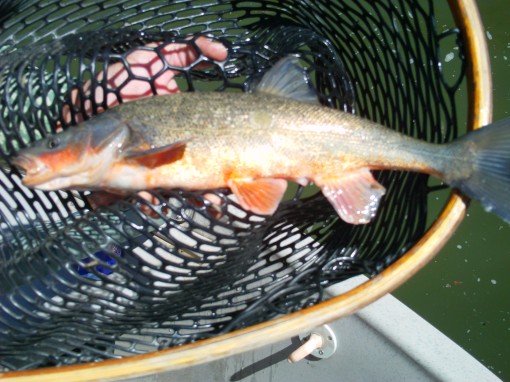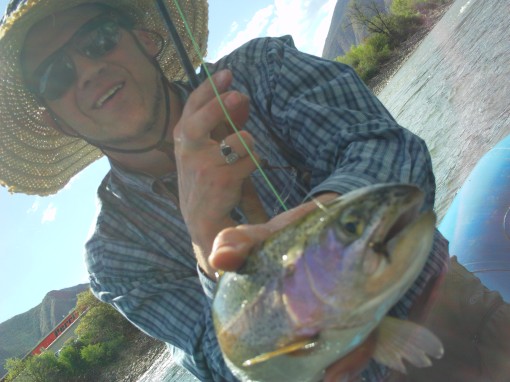12/2/2012
Finding the time to keep the blog updated through our busy season is impossible. Here is our year in summary from June through November.
It wasn’t as tragic as we all thought it could have been. While the continued low river flows changed everything, fish kill while still moderate, should have been a lot worse.
It was one of the driest springs and early summers that I can remember. The Roaring Fork sauna, where a hint of a spark had the potential to destroy neighborhoods, and almost did on several occasions. Like the juvenile’s lighting fireworks in Glenwood Springs, or the service truck that hit the powerline post and started a one-acre fire in Carbondale . We all are indebted to our local fire departments, and the quick response set up by the local and county officials, who worked together across county lines smoothly. Most impressive was the initial preventative posture directed by officials who were on stand-by every second, and patrolled daily. Our first significant rain, ironically came amidst fourth of July fireworks cancellations. This storm, left three-inches in two-hours, became the norm every afternoon in the Colorado River and Roaring Fork Valley’s. Some rains, so heavy and hard caused furious mud slides. Having driven through one, I felt as if there were drifts of snow, rather mud, that looked like a nasty snow storm had just left. Debris that remained mirrored post runoff conditions with new log jams everywhere. The Shoshone power plant reported, counting at least two-thousand bellied-up-fish sweeping through, after one such event.
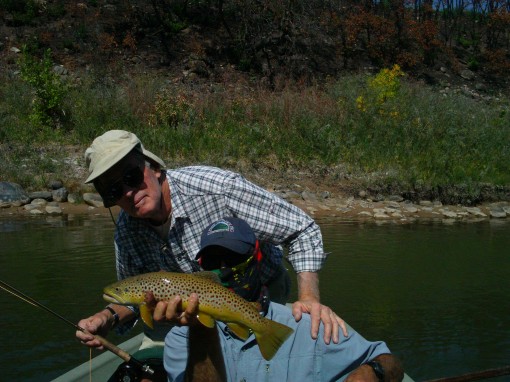
We hooked this one on an egg sucking leech in a slow run on the Colorado River.
April, May, June, and July gifted us with the best dry-fly fishing in many moons. Clear water, with low run-off values combined with early warm water temps (60 degrees plus), made for smorgasbord-blizzards of hatches. Mother’s Day cadis was early along with four other flavors of cadis. Stone-fly’s, Drakes, and PMD’s oh my. During a normal more consistent run-off year, any angler can follow these hatches as they work their way up river from lower elevations. This year, as well as last year (highest water flows in recorded history) we were able to fish the same hatches on four different river’s in the same day: Colorado, Roaring Fork, Crystal, and Fryingpan.
These early conditions were certainly not a bad thing for the fish. Not having to fight through the heavy raging water’s of a typical mountain run-off , and having clear-water conditions during our thickest hatches. Our fish, got up and feasted on ten Thanksgiving Day turkey’s, absolutely blowing the seams on their stomachs, and fattening their way into Jenny Craig. Through the year, local’s agreed, the fish in general were healthier, fatter, tenacious, and well-shouldered.
The department of Wildlife posted signs at boat-ramps, in preparation for the onslaught of tourists over the fourth. These warned of the potential dangers of high water temperature on fish habitat and how to avoid fish kill: not playing a fish for ever, using single-fly rigs rather than double or triple rigs, and fishing earlier in the day, to take advantage of cooler water temperatures.
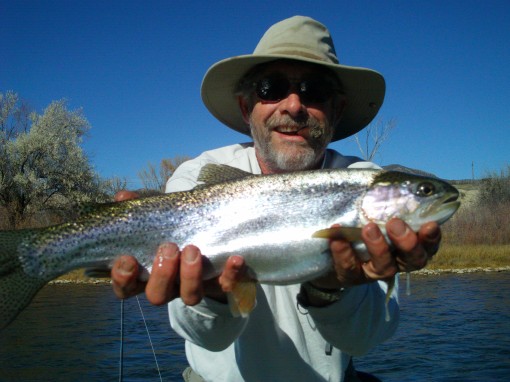
This Fat Rainbow shows how healthy the fish are all the way through Fall. A Birthday Fish for Phil Bethel
The Roaring Fork Conservancy, worked together well with the Department of Wildlife and local volunteers with their, “Hot Spots” group, who volunteered to be assigned a River monitor. They gave out thermometers and instructions, and asked volunteers to record their data on their public web-site. Some readings were scary high on the Colorado river in late June, exceeding seventy-degrees.
The Crystal River finally received national attention by its designation as one of the top-eight, most-endangered free-stone streams in the United States. This will definitely force more attention to this wonderful fishery. Currently, wild-life biologists work to restore the banks of Coal Creek, that was destroyed by the Mid-Contenent mine. This attempt seeds the ground, and then allows cattle to craze, who in-turn, churn up the dirt, making for a successful sustainable grow. Because, everyone knows why the water turns grey on the Crystal when we get a big rain…..mine run-off. Other sustainable river regulations are being addressed, like the, “use it, or lose it”, grand-fathered clause, water-right given to ranchers. This forces ranchers, regardless of conditions or needed usage to, take water off the crystal, or they will lose the right to the water.

This one ate a flash-prince about two-feet under the water. Hook jaw, and old wise fish can still be tricked if you are a master –
Fall, was beautiful and warm, yet water temperature stayed nice and cool with overnight low’s keeping the temperature healthy and consistent, bandaging the year’s drought conditions. Fish had a more different adaptation with the lack of water in creeks, forcing our elegant brown trout to primarily spawn on the river bed’s. It remains to be seen the number’s of trout that were successful. I would vote for all creeks and access points to creek,s to be closed during spring and fall spawning periods, to re-vitalize habitat.
Too, there are some changes on our horizon. Carbondale is one of the busiest boat ramps in the state. It has been leased and operated by the town of Carbondale, for the last three years, formerly owned by the Koziel family. The Department of Wildlife leased it from them in ten-year increments. Now, that the lease is still with the DOW, (6 years remain) and the Town of Carbondale owns the land, they have decided to sink several million in re-doing the ramp area. This is a good idea, and will allow: more space to put-in, a separate area for Kayak’s and non-commercial float trips, handicap access, and more. Thank you to the volunteers who showed up to represent the fly fishermen during the local Town of Carbondale’s steering committee meetings, and the town’s recreation department for thoroughly reviewing and listening too all the options available.
In a political time and times of change here in the Roaring Fork Valley here are some ideas I would vote yes on if given the opportunity : limiting the number of use day’s per day at Carbondale boat ramp, limiting the number of commercial permits allowed on river’s, allowing a public easement for wade fishing along the high water mark through-out the year on all river’s, Closing all creeks and creek mouths to fish spawn habitat in spring and fall. Limiting the number of flies an angler can use on their line to two. Completely eliminating any fishing contests, including the Rocky Mountain Classic Red bone, or anything that promotes catching as many fish as you can. Background, criminal, driving checks on all guides before allowing them river-worthy. What do you think will help establish a better fishery? Please Comment.
To fish with Jason Phillips, The true JP, or any of his world-renown fishing buddies, who just happen to be professionals, drop me an email: jp@globetrotteradventures.com . Click here to be connected to the Local’s Best fly shop, voted ten years in a row: Roaring Fork Anglers and Alpine Angling Phone: 970.963.9245 or visit my web site: Globetrotteradventures.com
